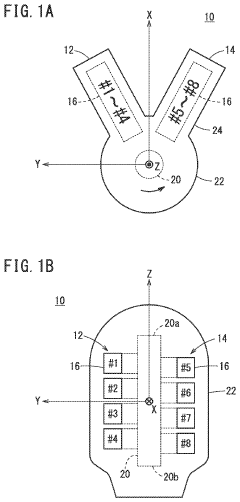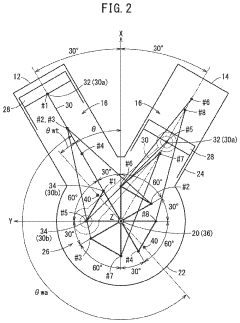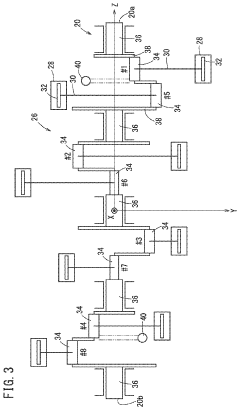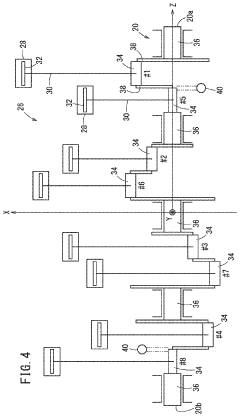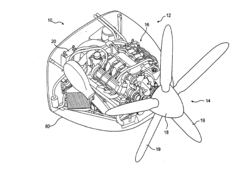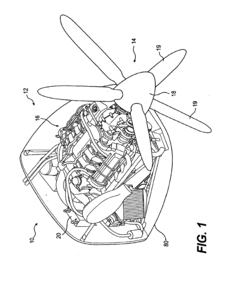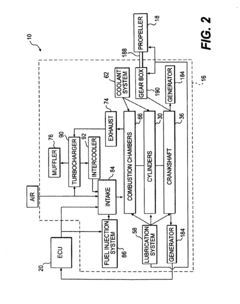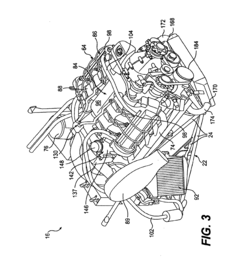How V8 Engines Are Integrated in Aerospace Engineering?
JUL 4, 20259 MIN READ
Generate Your Research Report Instantly with AI Agent
Patsnap Eureka helps you evaluate technical feasibility & market potential.
V8 Engine Aerospace Integration Background
The integration of V8 engines in aerospace engineering represents a significant technological advancement in the field of aviation. This powerful engine configuration, originally designed for automotive applications, has found its way into aerospace due to its high power-to-weight ratio and reliability. The journey of V8 engines in aerospace began in the mid-20th century, with early experiments in small aircraft and racing planes.
As aerospace technology progressed, engineers recognized the potential of V8 engines to provide substantial power in a compact package. This led to increased research and development efforts to adapt these engines for aviation purposes. The primary goal was to harness the V8's power while addressing the unique challenges of aerospace applications, such as altitude performance, fuel efficiency, and durability under extreme conditions.
The evolution of V8 engines in aerospace has been marked by several key milestones. Early adaptations focused on modifying existing automotive V8 engines for aircraft use. This involved redesigning cooling systems, adjusting fuel delivery mechanisms, and enhancing lubrication to cope with the demands of flight. As the technology matured, purpose-built aviation V8 engines emerged, specifically engineered to meet the stringent requirements of aerospace applications.
One of the most significant developments in this field was the introduction of lightweight materials and advanced manufacturing techniques. The use of aluminum alloys and, more recently, composite materials has dramatically reduced the weight of V8 engines while maintaining their structural integrity. This weight reduction is crucial in aerospace, where every pound matters in terms of fuel efficiency and aircraft performance.
The integration of V8 engines in aerospace has not been limited to fixed-wing aircraft. Helicopters and other rotary-wing aircraft have also benefited from V8 power plants, particularly in applications requiring high power output and reliability, such as heavy-lift operations and long-range missions.
Recent trends in V8 aerospace integration include the development of hybrid and electric systems. These innovations aim to combine the power and reliability of V8 engines with the efficiency and environmental benefits of electric propulsion. Such hybrid systems are seen as a potential bridge technology in the aerospace industry's transition towards more sustainable propulsion methods.
The ongoing research in V8 engine aerospace integration continues to push the boundaries of what is possible in aviation. Engineers are exploring advanced combustion technologies, novel fuel formulations, and sophisticated engine management systems to further enhance the performance and efficiency of V8 engines in aerospace applications. This continuous evolution underscores the enduring relevance of V8 engines in the ever-advancing field of aerospace engineering.
As aerospace technology progressed, engineers recognized the potential of V8 engines to provide substantial power in a compact package. This led to increased research and development efforts to adapt these engines for aviation purposes. The primary goal was to harness the V8's power while addressing the unique challenges of aerospace applications, such as altitude performance, fuel efficiency, and durability under extreme conditions.
The evolution of V8 engines in aerospace has been marked by several key milestones. Early adaptations focused on modifying existing automotive V8 engines for aircraft use. This involved redesigning cooling systems, adjusting fuel delivery mechanisms, and enhancing lubrication to cope with the demands of flight. As the technology matured, purpose-built aviation V8 engines emerged, specifically engineered to meet the stringent requirements of aerospace applications.
One of the most significant developments in this field was the introduction of lightweight materials and advanced manufacturing techniques. The use of aluminum alloys and, more recently, composite materials has dramatically reduced the weight of V8 engines while maintaining their structural integrity. This weight reduction is crucial in aerospace, where every pound matters in terms of fuel efficiency and aircraft performance.
The integration of V8 engines in aerospace has not been limited to fixed-wing aircraft. Helicopters and other rotary-wing aircraft have also benefited from V8 power plants, particularly in applications requiring high power output and reliability, such as heavy-lift operations and long-range missions.
Recent trends in V8 aerospace integration include the development of hybrid and electric systems. These innovations aim to combine the power and reliability of V8 engines with the efficiency and environmental benefits of electric propulsion. Such hybrid systems are seen as a potential bridge technology in the aerospace industry's transition towards more sustainable propulsion methods.
The ongoing research in V8 engine aerospace integration continues to push the boundaries of what is possible in aviation. Engineers are exploring advanced combustion technologies, novel fuel formulations, and sophisticated engine management systems to further enhance the performance and efficiency of V8 engines in aerospace applications. This continuous evolution underscores the enduring relevance of V8 engines in the ever-advancing field of aerospace engineering.
Aerospace Market Demand for V8 Engines
The aerospace industry has shown a growing interest in V8 engines due to their potential applications in various aircraft types. Market demand for V8 engines in aerospace engineering is primarily driven by the need for high-performance, fuel-efficient, and reliable powerplants for small to medium-sized aircraft, including general aviation, business jets, and certain military applications.
In the general aviation sector, V8 engines are increasingly sought after for their ability to provide substantial power output while maintaining relatively compact dimensions. This makes them particularly attractive for light aircraft and sport planes, where weight and space constraints are critical factors. The market for these engines is expected to grow as more private pilots and small aviation companies seek cost-effective alternatives to traditional aircraft engines.
The business jet segment represents another significant area of demand for V8 engines in aerospace. As corporations and high-net-worth individuals continue to prioritize efficient and flexible travel options, there is a growing market for smaller, more economical business jets. V8 engines offer an appealing balance of power, fuel efficiency, and reliability for this class of aircraft, potentially reducing operating costs and extending range capabilities.
Military and defense applications also contribute to the market demand for V8 engines in aerospace. These engines are being considered for use in unmanned aerial vehicles (UAVs), reconnaissance aircraft, and light transport planes. The military sector values the V8 engine's combination of power density, fuel efficiency, and durability, which are crucial for extended mission capabilities and reduced logistical burdens.
The demand for V8 engines in aerospace is further bolstered by advancements in materials science and engine management systems. Modern V8 designs incorporate lightweight alloys and advanced electronic control units, enhancing their suitability for aviation applications. This technological progress has expanded the potential market for V8 engines in aerospace, as they can now meet stringent aviation safety and performance standards.
Environmental considerations are also shaping the market demand for V8 engines in aerospace. As the industry faces increasing pressure to reduce emissions and improve fuel efficiency, V8 engines are being developed with advanced fuel injection systems and combustion technologies. This focus on environmental performance is opening up new market opportunities, particularly in regions with strict emissions regulations.
The aftermarket and maintenance sector represents another aspect of the aerospace market demand for V8 engines. As these engines become more prevalent in aircraft, there is a growing need for specialized maintenance services, spare parts, and overhaul capabilities. This creates additional market opportunities for engine manufacturers, maintenance, repair, and overhaul (MRO) providers, and parts suppliers within the aerospace industry.
In the general aviation sector, V8 engines are increasingly sought after for their ability to provide substantial power output while maintaining relatively compact dimensions. This makes them particularly attractive for light aircraft and sport planes, where weight and space constraints are critical factors. The market for these engines is expected to grow as more private pilots and small aviation companies seek cost-effective alternatives to traditional aircraft engines.
The business jet segment represents another significant area of demand for V8 engines in aerospace. As corporations and high-net-worth individuals continue to prioritize efficient and flexible travel options, there is a growing market for smaller, more economical business jets. V8 engines offer an appealing balance of power, fuel efficiency, and reliability for this class of aircraft, potentially reducing operating costs and extending range capabilities.
Military and defense applications also contribute to the market demand for V8 engines in aerospace. These engines are being considered for use in unmanned aerial vehicles (UAVs), reconnaissance aircraft, and light transport planes. The military sector values the V8 engine's combination of power density, fuel efficiency, and durability, which are crucial for extended mission capabilities and reduced logistical burdens.
The demand for V8 engines in aerospace is further bolstered by advancements in materials science and engine management systems. Modern V8 designs incorporate lightweight alloys and advanced electronic control units, enhancing their suitability for aviation applications. This technological progress has expanded the potential market for V8 engines in aerospace, as they can now meet stringent aviation safety and performance standards.
Environmental considerations are also shaping the market demand for V8 engines in aerospace. As the industry faces increasing pressure to reduce emissions and improve fuel efficiency, V8 engines are being developed with advanced fuel injection systems and combustion technologies. This focus on environmental performance is opening up new market opportunities, particularly in regions with strict emissions regulations.
The aftermarket and maintenance sector represents another aspect of the aerospace market demand for V8 engines. As these engines become more prevalent in aircraft, there is a growing need for specialized maintenance services, spare parts, and overhaul capabilities. This creates additional market opportunities for engine manufacturers, maintenance, repair, and overhaul (MRO) providers, and parts suppliers within the aerospace industry.
V8 Engine Aerospace Challenges
The integration of V8 engines in aerospace engineering presents several significant challenges that require innovative solutions and careful consideration. One of the primary obstacles is the adaptation of these engines, originally designed for automotive applications, to the unique demands of aerospace environments. The high-altitude operation, extreme temperature variations, and prolonged running times characteristic of aerospace applications place unprecedented stress on V8 engine components.
Weight reduction is another critical challenge in aerospace V8 engine integration. Traditional V8 engines are often too heavy for aircraft use, necessitating extensive redesign and material substitution to achieve an acceptable power-to-weight ratio. This process involves not only reducing the weight of the engine block and internal components but also optimizing the entire powertrain system for aerospace applications.
Fuel efficiency and emissions control pose additional hurdles. Aerospace regulations are increasingly stringent, requiring engines to operate with high efficiency while minimizing environmental impact. Adapting V8 engines to use aviation fuels and meet these stringent emissions standards without compromising performance is a complex engineering task.
Reliability and durability are paramount in aerospace applications, where engine failure can have catastrophic consequences. V8 engines must be re-engineered to withstand the rigors of aerospace use, including extended operation at high power settings, rapid altitude changes, and exposure to extreme environmental conditions. This necessitates the development of more robust materials, enhanced cooling systems, and advanced lubrication technologies.
Vibration and noise reduction present another set of challenges. The characteristic vibration patterns of V8 engines, while manageable in ground vehicles, can be problematic in aircraft, potentially causing structural fatigue and passenger discomfort. Engineers must develop sophisticated vibration dampening systems and redesign engine mounts to mitigate these issues.
Integration with aircraft systems poses further complications. V8 engines must be adapted to interface seamlessly with aircraft electrical, hydraulic, and control systems. This integration requires the development of specialized engine control units (ECUs) capable of managing the engine's performance across a wide range of flight conditions while communicating effectively with other aircraft systems.
Lastly, the certification process for aerospace V8 engines is exceptionally rigorous, requiring extensive testing and documentation to meet aviation safety standards. This process can be time-consuming and expensive, presenting a significant barrier to the widespread adoption of V8 engines in aerospace applications.
Weight reduction is another critical challenge in aerospace V8 engine integration. Traditional V8 engines are often too heavy for aircraft use, necessitating extensive redesign and material substitution to achieve an acceptable power-to-weight ratio. This process involves not only reducing the weight of the engine block and internal components but also optimizing the entire powertrain system for aerospace applications.
Fuel efficiency and emissions control pose additional hurdles. Aerospace regulations are increasingly stringent, requiring engines to operate with high efficiency while minimizing environmental impact. Adapting V8 engines to use aviation fuels and meet these stringent emissions standards without compromising performance is a complex engineering task.
Reliability and durability are paramount in aerospace applications, where engine failure can have catastrophic consequences. V8 engines must be re-engineered to withstand the rigors of aerospace use, including extended operation at high power settings, rapid altitude changes, and exposure to extreme environmental conditions. This necessitates the development of more robust materials, enhanced cooling systems, and advanced lubrication technologies.
Vibration and noise reduction present another set of challenges. The characteristic vibration patterns of V8 engines, while manageable in ground vehicles, can be problematic in aircraft, potentially causing structural fatigue and passenger discomfort. Engineers must develop sophisticated vibration dampening systems and redesign engine mounts to mitigate these issues.
Integration with aircraft systems poses further complications. V8 engines must be adapted to interface seamlessly with aircraft electrical, hydraulic, and control systems. This integration requires the development of specialized engine control units (ECUs) capable of managing the engine's performance across a wide range of flight conditions while communicating effectively with other aircraft systems.
Lastly, the certification process for aerospace V8 engines is exceptionally rigorous, requiring extensive testing and documentation to meet aviation safety standards. This process can be time-consuming and expensive, presenting a significant barrier to the widespread adoption of V8 engines in aerospace applications.
Current V8 Aerospace Integration Solutions
01 V8 Engine Design and Configuration
V8 engines are designed with eight cylinders arranged in two banks of four, forming a V-shape. This configuration allows for a compact design, improved balance, and higher power output compared to inline engines. Various aspects of V8 engine design, including cylinder arrangement, crankshaft configuration, and valve timing, are optimized for performance and efficiency.- V8 Engine Design and Configuration: V8 engines are designed with eight cylinders arranged in two banks of four, forming a V-shape. This configuration allows for a compact design, improved power output, and better balance compared to inline engines. Various aspects of V8 engine design, including cylinder arrangement, crankshaft configuration, and valve timing, are continuously optimized to enhance performance and efficiency.
- Fuel Injection Systems for V8 Engines: Advanced fuel injection systems are crucial for optimizing V8 engine performance. These systems precisely control fuel delivery to each cylinder, improving combustion efficiency, power output, and fuel economy. Innovations in direct injection, multi-port injection, and electronic fuel management contribute to enhanced V8 engine performance across various operating conditions.
- V8 Engine Cooling and Lubrication: Effective cooling and lubrication systems are essential for V8 engine reliability and longevity. Advanced cooling technologies, including improved radiator designs and precision-controlled coolant flow, help maintain optimal operating temperatures. Enhanced lubrication systems ensure proper oil distribution to critical engine components, reducing wear and extending engine life.
- V8 Engine Performance Enhancements: Various technologies are employed to enhance V8 engine performance, including turbocharging, supercharging, and variable valve timing. These advancements improve power output, torque delivery, and overall engine efficiency. Additionally, lightweight materials and advanced manufacturing techniques are used to reduce engine weight and improve power-to-weight ratios.
- Emissions Control in V8 Engines: Modern V8 engines incorporate advanced emissions control technologies to meet stringent environmental regulations. These include improved catalytic converters, exhaust gas recirculation systems, and particulate filters. Engine management systems are also optimized to reduce emissions while maintaining performance, often utilizing sophisticated sensors and control algorithms.
02 Fuel Injection Systems for V8 Engines
Advanced fuel injection systems are crucial for V8 engine performance and efficiency. These systems may include direct injection, multi-point injection, or a combination of both. Innovations in fuel injection technology focus on improving fuel atomization, precise fuel delivery, and optimizing combustion for better power output and reduced emissions.Expand Specific Solutions03 V8 Engine Cooling and Lubrication
Effective cooling and lubrication systems are essential for V8 engine reliability and longevity. Innovations in this area include advanced coolant circulation methods, oil cooling techniques, and improved lubricant formulations. These systems help manage the high heat output of V8 engines and ensure proper lubrication of critical components under various operating conditions.Expand Specific Solutions04 V8 Engine Performance Enhancement
Various technologies and methods are employed to enhance V8 engine performance. These may include turbocharging, supercharging, variable valve timing, and advanced engine management systems. Performance enhancements focus on increasing power output, improving torque characteristics, and optimizing fuel efficiency across different operating ranges.Expand Specific Solutions05 Emissions Control in V8 Engines
Emissions control is a critical aspect of modern V8 engine design. Technologies and systems are developed to reduce harmful exhaust emissions while maintaining performance. These may include advanced catalytic converters, exhaust gas recirculation systems, and particulate filters. Innovations in this area aim to meet increasingly stringent emissions regulations without compromising engine performance.Expand Specific Solutions
Key Aerospace V8 Engine Manufacturers
The integration of V8 engines in aerospace engineering represents a niche but evolving field, currently in its early development stages. The market size remains relatively small, primarily focused on experimental and light aircraft applications. Technologically, V8 engines in aerospace are still maturing, with companies like BMW, Honda, and Toyota leading research efforts. These automotive giants are leveraging their expertise in high-performance V8 engines to explore aerospace adaptations. Emerging players such as ZeroAvia are also contributing to advancements, particularly in the context of sustainable aviation solutions. The industry is witnessing a gradual shift towards more efficient and environmentally friendly propulsion systems, with V8 engines potentially playing a role in hybrid or alternative fuel configurations for specific aerospace applications.
Rolls-Royce Plc
Technical Solution: Rolls-Royce has been at the forefront of integrating V8 engines in aerospace engineering, particularly for small aircraft and unmanned aerial vehicles (UAVs). Their approach involves adapting automotive V8 engines for aviation use, focusing on weight reduction and reliability enhancement. They have developed a proprietary engine management system that optimizes fuel efficiency and power output for aerospace applications[1]. The company has also invested in advanced materials research, incorporating lightweight alloys and composites to reduce the overall weight of the engine while maintaining structural integrity[3]. Rolls-Royce's V8 aerospace engines feature a unique cooling system designed to operate efficiently at high altitudes, addressing one of the key challenges in adapting automotive engines for aviation use[5].
Strengths: Extensive experience in aerospace engineering, strong R&D capabilities, and established reputation in the industry. Weaknesses: Higher costs compared to traditional aircraft engines, and potential regulatory hurdles for certification in some markets.
ZeroAvia, Inc.
Technical Solution: ZeroAvia has been pioneering the integration of hydrogen-powered V8 engines in aerospace engineering, focusing on zero-emission aircraft propulsion. Their innovative approach involves adapting V8 engine architectures to run on hydrogen fuel, leveraging the high power-to-weight ratio of V8 designs. ZeroAvia has developed proprietary fuel cell stack technology that integrates with modified V8 engine blocks to create a hybrid hydrogen-electric powertrain[8]. The company has also invested in advanced control systems that optimize hydrogen fuel consumption and power output across various flight phases[10]. ZeroAvia's V8-based hydrogen powertrains feature cryogenic hydrogen storage solutions and specialized heat management systems to address the unique challenges of hydrogen fuel in aerospace applications[12].
Strengths: Cutting-edge hydrogen propulsion technology, strong focus on zero-emission aviation, and successful demonstration flights. Weaknesses: Challenges in hydrogen infrastructure development and potential regulatory hurdles for widespread adoption of hydrogen-powered aircraft.
V8 Aerospace Engine Innovations
V8 engine
PatentActiveUS11821359B2
Innovation
- The V8 engine configuration features crank pins arranged at 90° intervals on one bank and offset by 60° on the other bank, allowing for cancellation of primary inertia couples without additional specialized parts by optimizing the arrangement of crank pins and connecting rods.
Piston Type Aircraft Engine
PatentInactiveUS20080027620A1
Innovation
- A compact, lightweight piston-type internal combustion engine with a V-type configuration, featuring a closed-loop liquid cooling system, electronic control unit, and a propeller shaft, designed to meet FAA and RTCA guidelines, with a displacement of less than 19.6 liters and a power output of 140 to 600 horsepower, optimized for efficient operation at high altitudes and duty cycles.
Aerospace V8 Engine Regulations
The integration of V8 engines in aerospace engineering is subject to stringent regulations to ensure safety, reliability, and performance. These regulations are established and enforced by various aviation authorities worldwide, with the Federal Aviation Administration (FAA) in the United States and the European Union Aviation Safety Agency (EASA) being two of the most influential bodies.
Aerospace V8 engine regulations cover a wide range of aspects, including design, manufacturing, testing, and maintenance. One of the primary focuses is on engine certification, which requires manufacturers to demonstrate compliance with airworthiness standards. This process involves extensive testing and documentation to prove that the engine can operate safely under all expected conditions.
Regulations also address the materials used in V8 engine construction for aerospace applications. These materials must meet specific strength, durability, and heat resistance requirements to withstand the extreme conditions encountered during flight. Additionally, regulations mandate the use of fire-resistant materials in critical engine components to enhance safety in the event of a fire.
Engine performance and emissions are another crucial area of regulation. Aerospace V8 engines must meet strict fuel efficiency standards and comply with noise and emissions regulations. These requirements drive continuous innovation in engine design and fuel technology to reduce environmental impact while maintaining or improving performance.
Maintenance and inspection protocols for aerospace V8 engines are also heavily regulated. These regulations specify the frequency and scope of inspections, as well as the qualifications required for personnel performing maintenance tasks. Detailed record-keeping is mandatory to ensure traceability and accountability throughout the engine's lifecycle.
Regulations also cover the integration of V8 engines with aircraft systems. This includes requirements for engine mounting, fuel systems, electrical systems, and control interfaces. Manufacturers must demonstrate that the engine can operate safely and effectively as part of the overall aircraft system.
Emergency procedures and fail-safe mechanisms are another critical aspect of aerospace V8 engine regulations. These include requirements for engine shutdown systems, fire suppression, and containment of potential engine failures to prevent damage to other aircraft components.
As technology advances, regulations are continually updated to address new developments and potential risks. This includes emerging technologies such as electronic engine controls, advanced materials, and alternative fuels. Regulatory bodies work closely with industry stakeholders to ensure that regulations keep pace with technological progress while maintaining the highest standards of safety and reliability in aerospace engineering.
Aerospace V8 engine regulations cover a wide range of aspects, including design, manufacturing, testing, and maintenance. One of the primary focuses is on engine certification, which requires manufacturers to demonstrate compliance with airworthiness standards. This process involves extensive testing and documentation to prove that the engine can operate safely under all expected conditions.
Regulations also address the materials used in V8 engine construction for aerospace applications. These materials must meet specific strength, durability, and heat resistance requirements to withstand the extreme conditions encountered during flight. Additionally, regulations mandate the use of fire-resistant materials in critical engine components to enhance safety in the event of a fire.
Engine performance and emissions are another crucial area of regulation. Aerospace V8 engines must meet strict fuel efficiency standards and comply with noise and emissions regulations. These requirements drive continuous innovation in engine design and fuel technology to reduce environmental impact while maintaining or improving performance.
Maintenance and inspection protocols for aerospace V8 engines are also heavily regulated. These regulations specify the frequency and scope of inspections, as well as the qualifications required for personnel performing maintenance tasks. Detailed record-keeping is mandatory to ensure traceability and accountability throughout the engine's lifecycle.
Regulations also cover the integration of V8 engines with aircraft systems. This includes requirements for engine mounting, fuel systems, electrical systems, and control interfaces. Manufacturers must demonstrate that the engine can operate safely and effectively as part of the overall aircraft system.
Emergency procedures and fail-safe mechanisms are another critical aspect of aerospace V8 engine regulations. These include requirements for engine shutdown systems, fire suppression, and containment of potential engine failures to prevent damage to other aircraft components.
As technology advances, regulations are continually updated to address new developments and potential risks. This includes emerging technologies such as electronic engine controls, advanced materials, and alternative fuels. Regulatory bodies work closely with industry stakeholders to ensure that regulations keep pace with technological progress while maintaining the highest standards of safety and reliability in aerospace engineering.
V8 Engine Environmental Impact
The integration of V8 engines in aerospace engineering has significant environmental implications that warrant careful consideration. These powerful engines, while offering high performance capabilities, also contribute to various environmental concerns. One of the primary issues is the emission of greenhouse gases, particularly carbon dioxide, which is a major contributor to global warming and climate change. The combustion of aviation fuel in V8 engines releases substantial amounts of CO2 into the atmosphere, exacerbating the greenhouse effect.
Additionally, V8 engines in aerospace applications produce other pollutants such as nitrogen oxides (NOx) and particulate matter. These emissions can have detrimental effects on air quality, especially in areas surrounding airports and flight paths. NOx emissions contribute to the formation of smog and acid rain, while particulate matter can cause respiratory issues and visibility problems.
Noise pollution is another environmental concern associated with V8 engines in aerospace. The high-powered nature of these engines results in significant noise generation during takeoff, landing, and flight operations. This noise can have negative impacts on wildlife habitats and human communities near airports and along flight routes, potentially disrupting ecosystems and causing health issues for residents.
The production and disposal of V8 engines also have environmental implications. The manufacturing process involves the use of various materials and energy-intensive processes, contributing to resource depletion and industrial emissions. At the end of their lifecycle, the disposal or recycling of these engines presents challenges in terms of waste management and potential environmental contamination.
Fuel efficiency is a critical factor in assessing the environmental impact of V8 engines in aerospace. While these engines offer high power output, they may not always be the most fuel-efficient option. Increased fuel consumption leads to higher emissions and greater resource depletion, raising concerns about long-term sustainability in the aerospace industry.
To address these environmental challenges, ongoing research and development efforts are focused on improving the efficiency and reducing the environmental footprint of V8 engines in aerospace applications. This includes exploring alternative fuels, developing more efficient combustion technologies, and implementing advanced emission control systems. Additionally, there is a growing emphasis on the development of electric and hybrid propulsion systems as potential alternatives to traditional V8 engines in certain aerospace applications.
Additionally, V8 engines in aerospace applications produce other pollutants such as nitrogen oxides (NOx) and particulate matter. These emissions can have detrimental effects on air quality, especially in areas surrounding airports and flight paths. NOx emissions contribute to the formation of smog and acid rain, while particulate matter can cause respiratory issues and visibility problems.
Noise pollution is another environmental concern associated with V8 engines in aerospace. The high-powered nature of these engines results in significant noise generation during takeoff, landing, and flight operations. This noise can have negative impacts on wildlife habitats and human communities near airports and along flight routes, potentially disrupting ecosystems and causing health issues for residents.
The production and disposal of V8 engines also have environmental implications. The manufacturing process involves the use of various materials and energy-intensive processes, contributing to resource depletion and industrial emissions. At the end of their lifecycle, the disposal or recycling of these engines presents challenges in terms of waste management and potential environmental contamination.
Fuel efficiency is a critical factor in assessing the environmental impact of V8 engines in aerospace. While these engines offer high power output, they may not always be the most fuel-efficient option. Increased fuel consumption leads to higher emissions and greater resource depletion, raising concerns about long-term sustainability in the aerospace industry.
To address these environmental challenges, ongoing research and development efforts are focused on improving the efficiency and reducing the environmental footprint of V8 engines in aerospace applications. This includes exploring alternative fuels, developing more efficient combustion technologies, and implementing advanced emission control systems. Additionally, there is a growing emphasis on the development of electric and hybrid propulsion systems as potential alternatives to traditional V8 engines in certain aerospace applications.
Unlock deeper insights with Patsnap Eureka Quick Research — get a full tech report to explore trends and direct your research. Try now!
Generate Your Research Report Instantly with AI Agent
Supercharge your innovation with Patsnap Eureka AI Agent Platform!
